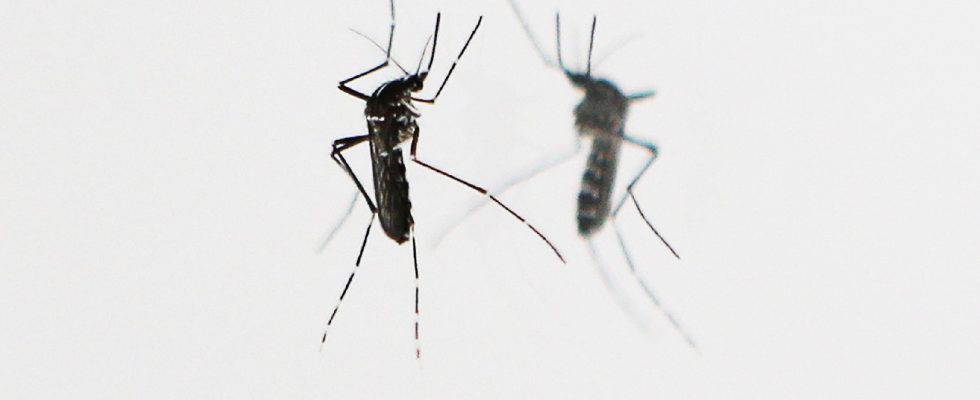At first glance, this pest seems harmless. Almost elegant in her striped dress. Small in size, the animal flies slower than its colleagues. However, the tiger mosquito risks coming to haunt our summer. A new time. The insect is implanted and active in 71% of French territory. And four new departments, mainly in Brittany, have been colored red on the map. “The colonization of French territory by the Tiger mosquito is increasingly rapid”, according to the site Mosquito Vigilance. It is now found in the very northern territories, such as in the Paris region.
The “Tiger mosquito” (scientific name Aedes albopictus) is a vector of viral diseases (chikungunya, dengue fever, zika). Installed since 2004 in France, the whole of the territory is concerned by a risk of development of diseases transmitted by mosquitoes. As a reminder, the mosquito is not, in itself, a carrier of the virus. “It will bite a person who is already infected. From there, the virus will multiply in the body of the mosquito, up to the level of the salivary glands. When the mosquito bites, it will inject the virus that it will have caught by the previous bite of an infected person”, explains to The Express Yannick Simonin, virologist and research professor at the University of Montpellier.
So, what to expect for the summer of 2023? “What we can declare with certainty is an increase in the number of cases of viral diseases transmitted by mosquitoes in the future. We expect more and more epidemic outbreaks in France”, replies Yannick Simonin. Forecasts that echo those of the Committee for monitoring and anticipating health risks (Covars). In a 60-page notice, published on April 5, the organization said it expected “in the years to come, an increase in cases of dengue fever, Zika and chikungunya”, arboviruses transmitted by these now widely known “vector” mosquitoes. established in the territory. In addition, the forthcoming organization of the Olympic Games and other major sporting events, attracting populations from all over the world, “reinforces the risk of occurrence of outbreaks of dengue fever, Zika and chikungunya”, indicates Covars.
On his side, the World Health Organization (WHO) also spoke on the subject. On Wednesday April 5, Raman Velayudhan, who coordinates the WHO’s dengue and arbovirus initiative, at a press conference, said that “climate change has played a key role in facilitating the spread of mosquito vectors”. That said, this expansion has other explanations: urbanization, trade or even international travel. “Like many invasive species, it has been able to take over other mosquito populations, in particular by taking advantage of flowerpot cups, gutters, water reserves in which it lays its eggs”, explained last September, in The ExpressDidier Fontenille, entomologist and director of research at the Research Institute for Development.
In recent years, the metropolis has recorded a growing number of autochthonous cases – that is to say not from contamination outside the territory – and outbreaks. Already last summer, the metropolis listed 65 cases of autochthonous dengue fever, recalls the Covars. A balance sheet that could be well below reality. “Dengue fever being often asymptomatic (in about 70% of cases), its circulation can go unnoticed. In addition, with the Covid-19 pandemic, the diagnosis of other viral diseases has probably been underestimated in the last two years” , estimated Yannick Simonin, in an article on The Conversation, last September. In mainland France, no serious form of the disease has been observed, unlike the overseas territories. Note that the most common symptoms are fever and joint pain.
Zika, dengue… Towards an increase in cases
What worries is the speed of spread of these infections on the territory. “Until now, the number of autochthonous dengue infections has remained very limited in mainland France. It has been estimated at less than thirty since the first case reported in 2010, with very often only a few infections identified per year”, adds Yannick Simonin. Note that the dengue virus is the one that spreads the fastest worldwide. And what about the others? Concerning chikungunya, the virus circulates significantly and small epidemic foci have been known in metropolitan France. From May 1 to December 9, 2022, 22 imported cases of chikungunya were recorded in mainland France, according to Public health France.
“On the Zika side, it’s a bit special. We had an epidemic in the years 2015-2016, so it’s difficult to know when it could come back. It’s a closely watched virus, because it’s more mysterious than the others. Its circulation is much less linear and appears somewhat randomly”, continues Yannick Simonin. Zika is a viral infection transmitted mainly by Aedes mosquitoes, and also sexually. From May 1 to December 9, 2022, three imported cases of Zika were recorded in mainland France. Symptoms are usually mild, but the virus can cause birth defects if infected during pregnancy.
What about virus circulation this year? From May 1 to November 30, which corresponds to its main period of activity, the health authorities will scrutinize its activity. “While we have one of the best surveillance systems in Europe, diagnosis is rare in humans. We must be prepared to better monitor these viruses and educate doctors on the issue. For example, if a person is infected with dengue fever, she will not think of doing a detection test”, explains to The Express Yannick Simonin. Objective of this monitoring: to increase awareness messages and trigger possible mosquito control operations.
